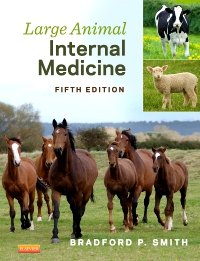
Large Animal Internal Medicine - Elsevier eBook on VitalSource, 5th Edition
Elsevier eBook on VitalSource

Large Animal Internal Medicine, 5th Edition features a problem-based approach to the diagnosis and management of disease in horses, cattle, sheep, and goats. It offers discussions of over 150 clinical signs and manifestations, as well as comprehensive coverage of laboratory and diagnostic testing. Thoroughly revised and updated content includes new vaccines and vaccination protocols; the most current laboratories for DNA, genetic, and PCR testing; and colostrum supplements and replacers. It’s everything your students need to stay up to date with the latest information on preventing and treating disease in large animals.
Newer Edition Available
Large Animal Internal Medicine - Elsevier eBook on VitalSource
-
- NEW! Extensively updated content from expert authors clarifies the latest research and clinical findings on pain, the nervous system, toxicology, BVD, malignant catarrhal fever, bluetongue, and strong ions.
- NEW! Vaccines and vaccination protocols keep students up to date with the information they need to prevent newly emerging diseases in large animals.
- NEW! Expanded coverage of the veterinarian’s role in animal welfare; equine abdominal ultrasound; DNA, genetic, and PCR testing; and colostrum supplements and replacers supplies students with the most current large animal internal medicine information.
- NEW! Current information on foreign animal diseases dangerous to large animals in the US, including coverage of rinderpest, keeps students aware of diseases that can be transmitted from other countries.
- Discussions of over 150 clinical signs or manifestations of disease provide students with a problem-based approach to diagnosis based on what they observe and what laboratory tests reveal.
- More than 200 expert authors contribute information in their areas of expertise for the most current, authoritative information on each topic.
- Color plates accompanying Diseases of the Eye and Diseases of the Alimentary Tract chapters illustrate the clinical appearance of ophthalmologic conditions and endoscopic views of equine alimentary tract disorders.
- Causes of Presenting Signs boxes offer quick access to the common, less common, and uncommon diseases associated with manifestations or signs of disease.
- Causes of Abnormal Laboratory Values boxes highlight the possible interpretations of abnormalities in clinical chemistry, hematology, blood proteins, and clotting tests.
- An extensive list of useful references on the companion website, many linked to their original source on PubMed, enables students to continue research on specific topics of interest.
- Thorough and extensive index makes it easy for students to quickly locate key information.
-
- NEW! Extensively updated content from expert authors clarifies the latest research and clinical findings on pain, the nervous system, toxicology, BVD, malignant catarrhal fever, bluetongue, and strong ions.
- NEW! Vaccines and vaccination protocols keep you up-to-date with the information you need to prevent newly emerging diseases in large animals.
- NEW! Expanded coverage of the veterinarian’s role in animal welfare; equine abdominal ultrasound; DNA, genetic, and PCR testing; and colostrum supplements and replacers supplies you with the most current large animal internal medicine information.
- NEW! Current information on foreign animal diseases dangerous to large animals in the US, including coverage of rinderpest, keeps you aware of diseases that can be transmitted from other countries.
-
PART I: HISTORY, PHYSICAL EXAMINATION, AND MEDICAL RECORDS
1. Ruminant History, Physical Examination, Welfare Assessment and Records
2. Equine History, Physical Examination, Records, and Recognizing Abuse or Neglect in PatientsPART II: MANIFESTATIONS OF DISEASE
3. Pain
4. Alterations in Body Temperature
5. Alterations in Respiratory Function
6. Alterations in Cardiovascular and Hemolymphatic Systems
7. Alterations in Alimentary and Hepatic Function
8. Localization and Differentiation of Neurologic Diseases
9. Alterations in Body Weight or Size
10. Alterations in Urinary Function
11. Alterations in the Skin
12. Alterations in Sexual Function
13. Musculoskeletal Abnormalities
14. Collapse and Sudden DeathPART III: DISORDERS AND MANAGEMENT OF THE NEONATE
15. The Peripartum Mare
16. Assessment of the Newborn Foal
17. Manifestations and Management of Disease in Neonatal Foals
18. The Peripartum Ruminant
19. Initial Management and Physical Examination of Neonatal Ruminants
20. Manifestations and Management of Disease in Neonatal Ruminants
21. Colostrum and Milk ReplacersPART IV: COLLECTION OF SAMPLES AND INTERPRETATION OF LABORATORY TESTS
22. Clinical Chemistry Tests
23. Collection and Submission of Samples for Cytologic and Hematologic Studies
24. Alterations in the Erythron
25. Alterations in the Leukogram
26. Alterations in Blood Proteins
27. Alterations in Hemostasis
28. Collection and Analysis of Bone Marrow
29. Molecular Diagnostics in Large AnimalsPART V: DISORDERS OF THE ORGAN SYSTEMS
30. Diseases of the Cardiovascular System
31. Diseases of the Respiratory System
32. Diseases of the Alimentary Tract
33. Diseases of Hepatobiliary System
34. Diseases of the Renal System
35. Diseases of the Nervous System
36. Mammary Gland Health and Disorders
37. Diseases of the Hematopoietic and Hemolymphatic Systems
38. Diseases of the Bones, Joints, and Connective Tissues
39. Diseases of the Eye
40. Diseases of the Skin
41. Endocrine and Metabolic Diseases
42. Diseases of Muscles
43. Diseases of the Reproductive SystemPART VI: PREVENTATIVE AND THERAPEUTIC STRATEGIES
44. Critical Care and Fluid Therapy
45. Principles of Antimicrobial Therapy
46. Biosecurity and Infection Control for Large Animal Practices
47. Prevention, Detection, and Response to Foreign Animal Diseases
48. Use of Biologics in the Prevention of Infectious Diseases
49. Parasite Control Programs
50. Nutrition of the Sick AnimalPART VII: CONGENTIAL, HEREDITARY, IMMUNOLOGIC, AND TOXIC DISORDERS
51. Genetic Disorders
52. Genetic Tests for Large Animals
53. Immunologic Disorders
54. Disorders Caused by Toxicants


 as described in our
as described in our 